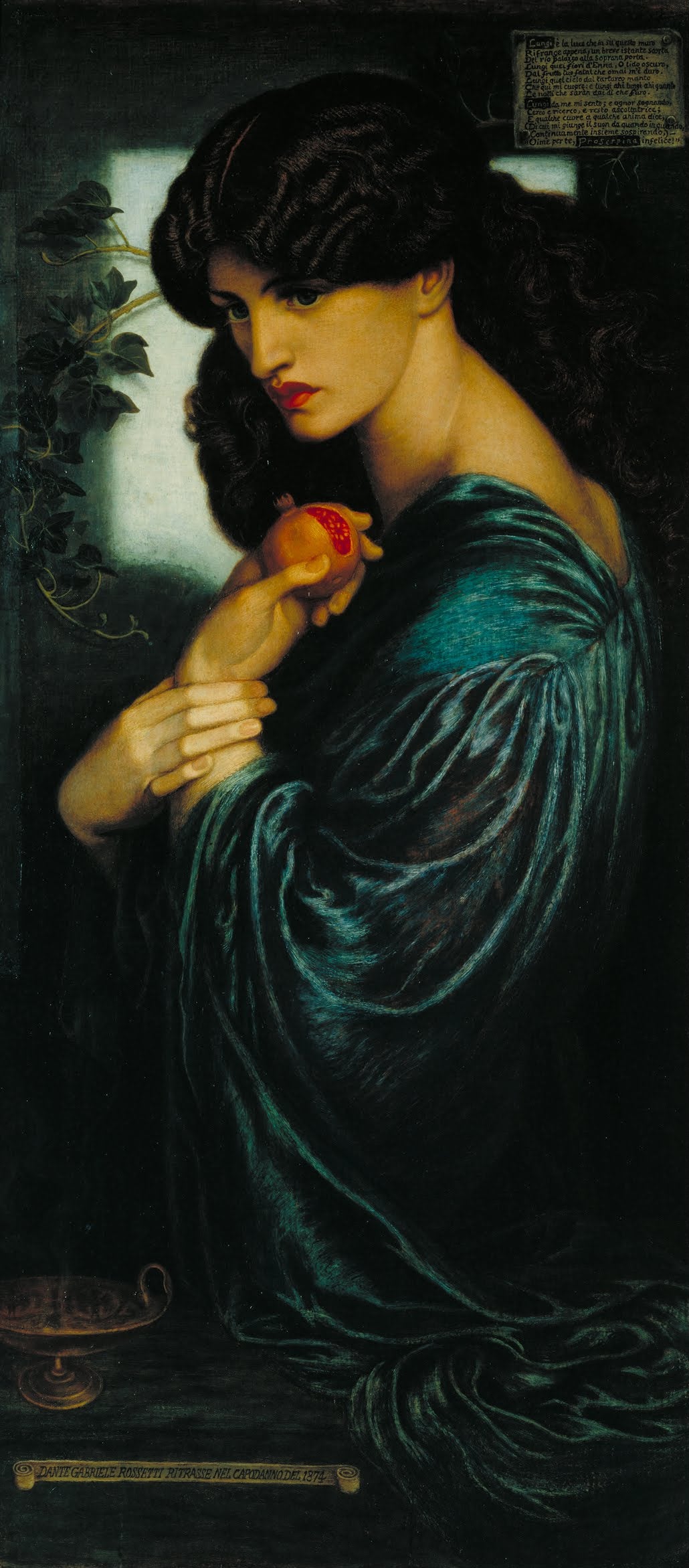Romantic English
Proserpine, Dante Gabriel Rossetti, 1874
Proserpine, Dante Gabriel Rossetti, 1874
Couldn't load pickup availability
This striking image, likely created by Dante Gabriel Rossetti, is an iconic portrayal of myth, temptation, and symbolism — most certainly the depiction of Persephone, the fabled Queen of the Underworld. The painting is rich in symbolic weight, executed in that unmistakably lush and deeply sensuous style that defined Rossetti and much of the Pre-Raphaelite Brotherhood. Every detail is imbued with narrative and meaning, drawing the viewer into a world where myth meets visual poetry.
At the center of the composition is the figure of Persephone herself, caught in a moment of quiet, solemn reflection. Her posture is graceful, yet melancholic, her hands delicately holding the fatal pomegranate—an infamous symbol of her entrapment in the underworld. The fruit is rendered in exquisite detail, its juicy, blood-red seeds bursting from the skin, reminiscent of temptation, desire, and the inescapable consequences of her choice. Persephone's fingers curl gently around the fruit, the gesture both tender and fateful, as if this single moment has sealed her destiny.
Her face is turned slightly to the left, yet her gaze is distant, averted, and introspective. Her eyes, heavy-lidded and thoughtful, seem lost in contemplation, as though she is caught between worlds—neither fully present in the one above nor the one below. Rossetti has imbued her features with a quiet intensity, her full lips painted in a deep, rich red, and her complexion porcelain-like, creating a stark contrast to the darker elements of the composition. Her expression is that of quiet resignation, as though she understands the gravity of her fate and has accepted it with a sense of quiet dignity.
Her hair, a rich and dark cascade of curls, frames her face in soft, almost hypnotic waves. It is deep and lustrous, each strand painstakingly rendered, creating a luxuriant texture that contrasts against the smoothness of her skin. The light plays subtly off her tresses, giving them depth and volume, and they seem to encircle her face like a dark halo, enhancing her sense of otherworldliness.
But it is her garment that demands special attention. She is draped in a sumptuous, emerald-green robe—heavy, velvety, and resplendent with folds that catch the light in intricate, mesmerizing patterns. The richness of the fabric gives the sense that Persephone is swathed in the weight of her role as both a goddess of life and a queen of the dead. The green of her robe is not a bright, verdant green, but a deep, earthy tone, suggesting that her connection to nature is no longer one of pure fertility and growth, but of decay and renewal—a constant cycle of life and death.
To the side, curling tendrils of ivy reach out from the shadows, symbolizing Persephone’s eternal tie to the earth and the world above. Ivy, often associated with immortality and fidelity, serves here as a subtle reminder of her connection to life, even as she reigns over the land of the dead.
At the bottom of the painting, there is an ancient lamp, softly glowing in the darkness. Its presence, almost understated, is another emblem of the underworld—a vessel that lights the way through the shadows. The faint light emanating from the lamp contrasts with the cold, dark environment, symbolizing the flicker of hope or the inevitability of passage through the underworld.
Behind Persephone, set into the wall, we see a faintly illuminated inscription—a hint of the lore that surrounds her, possibly in Italian or Latin. This is a reminder of the mythic weight of her story, forever tied to her betrayal by the fateful fruit and her cyclical return from the darkened realms to the bright, living world above. The text evokes a sense of timelessness, anchoring the image in a broader, historical, and literary context.
The contrast between light and shadow in this painting is one of Rossetti’s most masterful touches. The background fades into darkness, allowing the soft light that illuminates Persephone to take center stage. The lighting is almost theatrical, casting deep shadows across the folds of her gown and the contours of her face, enhancing the sense of mood and isolation. It feels as though she is suspended in a moment of quiet reflection, as if time itself has slowed to a crawl, and we are witness to her internal world—a world of loss, memory, and longing.
This painting is both sensual and sorrowful, capturing the essence of Persephone’s eternal duality. She is a figure of both beauty and melancholy, trapped between the world of the living and the dead, forever marked by her fateful choice. Rossetti, with his usual flair for romanticism and symbolism, has created a work that resonates deeply with the viewer, drawing us into the myth, while also allowing us to feel the quiet tragedy of Persephone’s plight. It is a painting that lingers long after the first viewing, leaving us to ponder the complexities of fate, desire, and consequence.
Share


